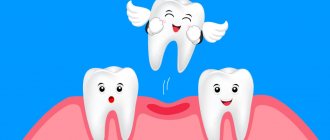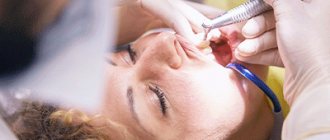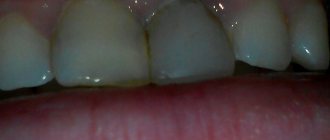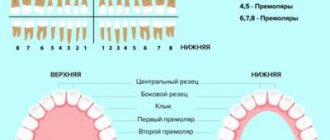According to statistics, caries occurs more often in children than in adults. This is one of the most common reasons for visiting a dentist, because not only permanent teeth, but also baby teeth are susceptible to destruction.
Children do not like to be treated, and often parents feel sorry for the child until the last moment and do not take him to the dentist in order to avoid stressful situations. But you need to understand that the health of his teeth in adulthood will depend on how they care for their baby’s oral cavity in childhood.
What are the causes of caries in children
The appearance of caries can be due to various reasons.
Insufficient or incorrect hygiene
Children most often do not want to brush their teeth - they are capricious because they do not like the process itself or the taste of the toothpaste. And parents often follow the lead and let the situation take its course, without insisting on the need for this procedure. However, it is necessary to teach a child to brush their teeth from a very early age, so that by the age of two the child himself shows a desire to take care of his teeth. Dentists recommend starting caries prevention immediately after the first teeth erupt.
Prolonged contact with the pacifier
In dentistry there is such a thing as “bottle caries”. It can develop before the age of 1 year, when the child is fed too long and often from a bottle with a nipple. Most often, such caries affects the upper front teeth, and the consequences are really serious.
Transmission of infection from parents
Many people are familiar with the situation when a child suddenly dropped a pacifier on the floor, the mother quickly picked it up, licked it and returned it to the baby. It's not as harmless as it might seem. This is how bacteria are transmitted that cause caries. For the same reason, you should not lick the baby's spoon when feeding. The infection can be transmitted even through kissing, so parents and other relatives who are in close contact with the child should carefully monitor the health of their teeth.
Congenital problems
Often, dental problems are congenital in nature. This may be genetic or caused by health problems in the mother during pregnancy. Bad habits, past illnesses, deficiency of vitamins and minerals (especially calcium) - all this affects the dental health of the unborn baby.
Abuse of sweets and carbohydrate foods
This is the most common cause of dental caries. Too much love for sweets is not good for children's teeth. Sweets, juices, lemonades, buns and cookies - all this creates a favorable environment for the development of bacteria and subsequent destruction of enamel.
Lack or excess of fluoride
Fluoride is necessary for the normal formation of teeth and to protect them from damage. We get it from food and water, and it is better to periodically get tested for the content of this element in the body in order to adjust nutrition and care in a timely manner. Both deficiency and excessive amounts of fluoride provoke dental problems.
What to do if your teeth turn black
An important role is played by the structure of the child’s tooth enamel, which directly depends on heredity, as well as the composition of the saliva that washes the surface of the tooth. When the required composition of saliva is disrupted (which occurs when there is a deficiency of fats, carbohydrates, fats, vitamins or minerals), plaque appears on the teeth. This is what causes teeth to darken. Do not try to get rid of it by brushing your teeth - this is useless, as the plaque will appear again. The way out of this situation will be to revise the children's diet, which should include foods rich in calcium, iron and other substances useful for strengthening teeth, including carrots, apples, cottage cheese and other dairy products, and, of course, fish. If a child’s teeth turn black, the first thing you should do is consult a dentist to find out the reasons for this process. Don't neglect your baby's teeth, because childhood caries develops quickly and can lead to undesirable consequences in the future if it is not prevented in time.
What are the stages of dental caries in children?
Tooth decay begins gradually, and with regular examination, parents and the dentist can catch the right moment in time and begin treatment.
| Initial stage Specks appear on the enamel, which differ in color from the rest of the tooth, and over time they darken. | Superficial caries The tooth decay is still minor, but the child is already beginning to react to hot and cold. | Average caries A carious cavity appears at the site of enamel destruction; the tooth reacts very painfully to the temperature of food and drinks. | Deep caries The last stage is when not only the enamel is destroyed, but also the tooth tissue itself. If treatment measures are not taken, then inflammation of the pulp will gradually begin, and the tooth will have to be removed. |
It is better not to delay the examination, because caries in a child can develop quite quickly. The further you go, the more uncomfortable and worrying your first visit to the doctor will be.
How is baby teeth treated?
Treatment of caries in children is carried out only by a pediatric dentist, since the structure of a child’s teeth differs from that of an adult. The doctor must provide psychological comfort for the little patient, otherwise the next visit will be problematic.
The treatment technique has some differences:
- superficial caries can be treated using the silvering method or the application of special remineralizing and fluoridating pastes without the use of a drill;
- when treating moderate caries, special materials and fillings that are safe for children are used; with deep caries and the development of pulpitis, tooth extraction is often resorted to.
Is it necessary to treat caries of baby teeth?
Despite the “temporary nature” of children’s teeth, treatment and care for them must be thorough and complete. Chronic inflammation in the oral cavity leads to serious problems.
- A baby tooth affected by caries can decay so deeply that it affects the germ of a permanent tooth. The infection will spread to it, and it will grow up with enamel defects or simply die.
- When a baby tooth is removed, the adjacent tooth moves into its place, causing the permanent tooth to erupt in a different place than intended. As a result, the bite is formed incorrectly, and in the future it has to be corrected with braces.
- Advanced caries reduces immunity and causes ENT diseases and even allergies.
- Painful sensations prevent the baby from biting and chewing food correctly, which causes digestive problems.
- The child will be embarrassed about his bad teeth, which will prevent him from communicating with his peers.
It is necessary to treat caries at any age at the initial stage, and it is better to accustom your child to this in advance.
Symptoms
The process of tooth decay develops gradually. First, a light, rough spot appears on the surface of the enamel - a focus of demineralization. Then dark pigmentation becomes noticeable on the surface of the tooth; this is the stage of superficial caries. Later, the carious lesion affects the dentin tissue. If you do not consult a dentist in time, deep caries will occur, and then pulpitis. The crown part of the tooth will be completely destroyed.
Rotten teeth in children cause the following symptoms:
- bad breath;
- reaction to hot and cold;
- the presence of a layer of plaque or tartar;
- swelling and soreness of the gums.
Rotten chewing teeth in children may have deep carious lesions, so-called “holes”. Decaying front teeth can be destroyed almost to the ground, sometimes only some parts remain. Teeth affected by medium and deep caries have dark brown spots on the enamel surface. Often, baby teeth are affected by cervical caries, then the crown part begins to collapse in the neck of the tooth, near the gums.
Can a filling be placed on a baby tooth?
If the doctor diagnoses not the first stage of tooth decay and insists that it is necessary to put a filling, it is better to agree with him. This is the fastest and most reliable way to solve the problem of infection and protect permanent teeth.
Modern filling materials are as safe as possible for children’s teeth. Depending on the stage of caries, the doctor will select a suitable filling option. Before installing a permanent filling, the dentist may place a temporary filling for several days to fix the medication inside the diseased tooth.
If the damage is not yet serious, the doctor will limit himself to preventive measures. There are different approaches and tools for different problems.
Diagnosis of caries
Treatment of caries depends on the stage, which is detected during a diagnostic examination. If a carious lesion is suspected, the dentist may prescribe the following procedures:
- Test staining: a solution is applied to the enamel, which colors the areas of demineralization purple. The method is suitable for the first and second stages.
- X-ray: the pictures show even hidden carious lesions, including under the gums and on the tooth root.
- Laser diagnostics: allows you to identify caries and assess the extent of its spread.
This pathology is treated therapeutically or with filling.
What are the treatment methods for caries in children?
Treatment methods depend on the stage of caries development. The more serious the problem, the longer it will take to fix it.
Preventive
At the initial stage, a delicate intervention is sufficient, which can stop or reverse the process of destruction that has begun. In this case, for example, remineralization (treatment of teeth with a solution of calcium and fluoride) or deep fluoridation (treatment with fluoride) is used. Such procedures are carried out in courses until the condition of the teeth is stabilized.
There is also a treatment method without drilling, which allows you to quickly and completely painlessly prevent the development of inflammation. The procedure is suitable for children from 4–5 years of age and causes them minimal discomfort.
Medicinal
For medium and deep caries, classical filling with preliminary preparation of teeth for the procedure is already necessary. To ensure that the treatment is calm and painless, the most modern and effective anesthesia is used. Your baby doesn’t even have to endure the pain of the needle because the injection site is first numbed. The drill is used to a minimum in the treatment of childhood caries - if something can be done manually, then the doctor will do so.
If a child has a complex case of caries, or is very restless in the dentist's chair, treatment is carried out under anesthesia. After consulting with an anesthesiologist and passing all the necessary tests, the baby will be selected the appropriate drug and dose, he will be put into deep sleep, during which the doctor will carefully monitor the condition of the body. Time will fly by in a dream - the child will wake up with healthy teeth, a clear head and an unspoiled mood.
The main causes of decay of baby teeth
There are two age peaks when enamel damage is most intense. This is the early childhood period, when drinking a bottle is still relevant, as well as reaching 4-5 years of age. The reasons leading to bad baby teeth are practically the same.
The main factors contributing to the destruction of enamel can be represented as follows:
- hereditary predisposition;
- previous cold infections during the first trimester of pregnancy;
- excess carbohydrates in food;
- the baby’s habit of drinking sweets from a bottle before bed;
- poor oral hygiene;
- lack of calcium ions in the diet;
- weak immunity – frequent colds.
In children under 2-3 years of age, the front teeth more often deteriorate, and then in the older period - all the rest. Initially, this is due to the fact that it is the carbohydrate residues that settle after using the bottle that destroy the enamel of baby teeth.
How to prevent tooth decay in children
The best way to combat tooth decay is prevention. To maintain the health of children's teeth, you need to follow several rules.
- Follow your diet. Reduce your consumption of sweets as much as possible. Make sure your child gets enough calcium from their diet - dairy products, nuts, legumes and sesame are especially rich in it.
- Teach your child to brush their teeth. From the first tooth that emerges (age 6–8 months), you can already use a small baby brush. Gradually accustom your child to self-care - buy tasty toothpaste, turn the process of brushing your teeth into a game, encourage your baby’s interest.
- Visit your dentist regularly. Children need to undergo preventive examinations, as well as professional hygiene procedures more often than adults - approximately once every three months. The doctor will be able to identify problems in a timely manner and give advice on the proper care of children’s teeth. In addition, visits to the doctor will become routine for the baby, and he will not be afraid of them.
Try to carefully monitor the condition of your child’s teeth and pay attention to his complaints. The sooner you see a dentist, the faster, more effective, and most importantly, painless the treatment will be. Explain to your child that dentistry is not scary. And our experienced doctors will help him make sure of this.
To protect children's teeth from further damage, it is necessary:
- make sure that there are no cracks on them, which become “gates” for caries-forming bacteria (cracks usually occur as a result of injuries);
- maintain oral hygiene, which will prevent the formation of plaque (the child should brush his teeth twice a day with age-appropriate toothpaste);
- supplement the menu with protein products that help strengthen enamel, as well as seasonal vegetables and fruits;
- if this is not possible, select a vitamin-mineral complex with the help of a pediatrician.











